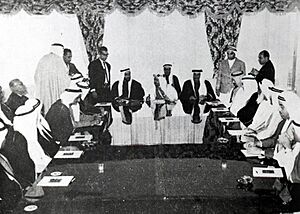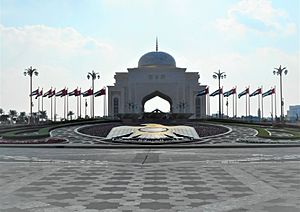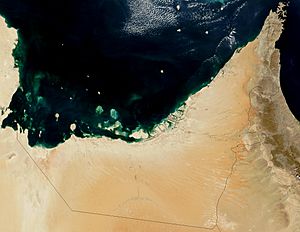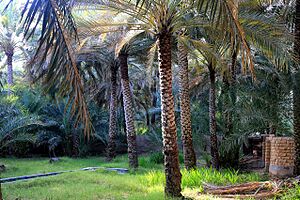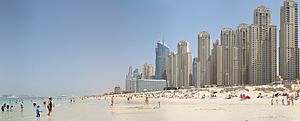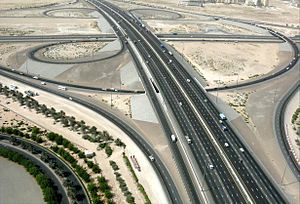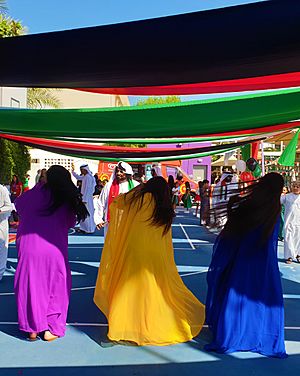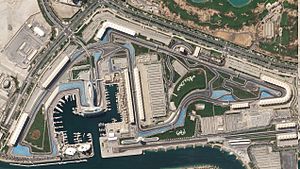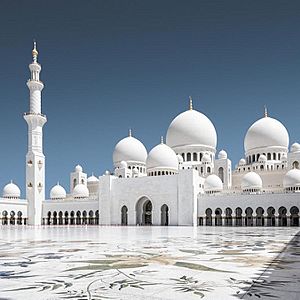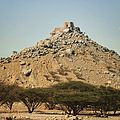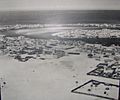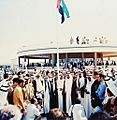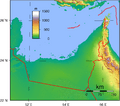United Arab Emirates facts for kids
Quick facts for kids
United Arab Emirates
الإمارات العربية المتحدة
Al-Imārāt al-‘Arabīyah al-Muttaḥidah |
|
|---|---|
|
Motto: الله الوطن الرئيس
"God, Nation, President"
|
|
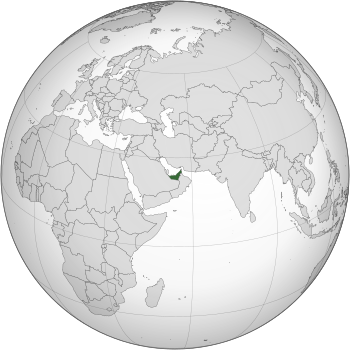
Location of United Arab Emirates (green)
in the Arabian Peninsula |
|
| Capital | Abu Dhabi 24°28′N 54°22′E / 24.467°N 54.367°E |
| Largest city | Dubai 25°15′N 55°18′E / 25.250°N 55.300°E |
| Official languages | Arabic |
| Common languages | Emirati Arabic, English |
| Ethnic groups
(2015)
|
|
| Religion
(2020)
|
|
| Demonym(s) | Emirati |
| Government | Federal Islamic semi-constitutional monarchy |
| Mohamed bin Zayed Al Nahyan | |
| Mohammed bin Rashid Al Maktoum | |
|
• Vice Presidents
|
|
| Legislature |
|
| Establishment | |
|
• British protectorate as part of Persian Gulf Residency
|
1820 and 1892 |
|
• Independence from the United Kingdom
|
2 December 1971 |
|
• Admitted to the United Nations
|
9 December 1971 |
|
• Admission of Ras Al Khaimah
|
10 February 1972 |
| Area | |
|
• Total
|
83,600 km2 (32,300 sq mi) (114th) |
|
• Water (%)
|
negligible |
| Population | |
|
• 2024 estimate
|
11,027,129 |
|
• 2005 census
|
4,106,427 |
|
• Density
|
132/km2 (341.9/sq mi) |
| GDP (PPP) | 2024 estimate |
|
• Total
|
|
|
• Per capita
|
|
| GDP (nominal) | 2024 estimate |
|
• Total
|
|
|
• Per capita
|
|
| Gini (2018) | 26 low |
| HDI (2022) | very high · 17th |
| Currency | UAE dirham (AED) |
| Time zone | UTC+04:00 (GST) |
| Date format | dd/mm/yyyy (AD) |
| Driving side | right |
| Calling code | +971 |
| ISO 3166 code | AE |
| Internet TLD |
|
|
United Arab Emirates portal
|
|
The United Arab Emirates (UAE) is a country in West Asia. It is located at the eastern end of the Arabian Peninsula. The UAE shares land borders with Oman and Saudi Arabia. It also has sea borders in the Persian Gulf with Qatar and Iran. Abu Dhabi is the nation's capital city. Dubai is the largest city and a major international center. In 2024, the UAE has over 10 million people.
The UAE is a special type of monarchy. It is a federation of seven emirates. These emirates are Abu Dhabi, Ajman, Dubai, Fujairah, Ras Al Khaimah, Sharjah, and Umm Al Quwain. Each emirate has its own ruler. These rulers together form the Federal Supreme Council. The Council members choose a president and vice president. Currently, Mohamed bin Zayed Al Nahyan is the president. Mohammed bin Rashid Al Maktoum and Mansour bin Zayed Al Nahyan are the vice presidents. The ruler of Abu Dhabi is usually the president. The ruler of Dubai is often the vice president and prime minister.
Islam is the official religion of the UAE. Arabic is the official language. The UAE has the world's sixth-largest oil reserves. It also has the seventh-largest natural gas reserves. Zayed bin Sultan Al Nahyan was the first president. He used oil money to improve healthcare, education, and buildings. The UAE has a very diverse economy. It relies less on oil and gas now. The country focuses more on tourism and business. The UAE is a member of the United Nations and other important groups.
Contents
History of the UAE
The earliest signs of humans in the UAE are from 7000 years BCE. The area was once part of a historical region called "Oman." This region included parts of modern Oman and the UAE. The Emirates have over 330 historical sites. Some of these date back to the Stone Age.
When Islam began to spread, the Arabian Gulf was one of the first areas to welcome Muslim missionaries. During the Ummayad period, the region was stable. It became a global center for shipping. The Portuguese arrived in the 15th century. They were looking for new trade routes to India. The explorer Vasco da Gama was the first to reach India from Europe by sailing around Africa. The Portuguese controlled the harbors for over 200 years. Later, in the 18th and 19th centuries, Great Britain took control for political and financial reasons.
In 1968, the British announced they would leave their colonies. On December 2, 1971, the United Arab Emirates was formed. Zayed bin Sultan Al Nahyan became the first president. Rashid bin Saeed Al Maktoum, the ruler of Dubai, became the vice president. Six emirates united at first. Ras Al Khaimah joined the UAE in 1972. After President Zayed bin Sultan Al Nahyan passed away, his son Khalifa bin Zayed Al Nahyan became the second president. After his death in May 2022, his brother Mohamed bin Zayed Al Nahyan became the third president.
Government and Politics
The United Arab Emirates is a federal constitutional monarchy. It is made up of seven hereditary tribal units called Sheikhdoms. The country is governed by a Federal Supreme Council. This Council includes the ruling Sheikhs of all seven emirates. Each emirate handles its own responsibilities not given to the federal government.
The rulers of the emirates are called Sheikhs. This title is used because of the tribal culture. A Sheikh is a leader or tribal chief who makes decisions with his people. The president and vice president are chosen by the Federal Supreme Council. Usually, the head of the Al Nahyan family from Abu Dhabi is the president. The head of the Al Maktoum family from Dubai is usually the prime minister.
The federal government has three main parts:
- Legislative: This includes the Federal Supreme Council and the Federal National Council (FNC).
- Executive: This includes the President, the prime minister, and the Council of Ministers.
- Judicial: This includes the Supreme Court and other federal courts.
The UAE e-Government is the online version of the federal government. The Council of Ministers manages all internal and foreign affairs. The prime minister leads this council. In 2019, the UAE became one of the few countries with 50% women in its lower house of parliament.
The UAE is unique for having special ministries. These include the Ministry of Tolerance, the Ministry of Happiness, and the Ministry of Artificial Intelligence. There is also a virtual Ministry of Possibilities. This ministry aims to find solutions to challenges and improve life. The UAE also has a National Youth Council. This council is represented by the Minister of Youth.
The Federal National Council (FNC) is the UAE's legislative body. Elections are held every four years. The FNC has 40 members from all emirates. Half are chosen by the rulers, and half are elected. By law, there must be an equal number of men and women. The FNC mainly gives advice.
Geography of the UAE
The United Arab Emirates is in the Middle East. It borders the Gulf of Oman and the Persian Gulf. It is located between Oman and Saudi Arabia. The UAE is south of the Strait of Hormuz. This strait is a key point for world crude oil transport.
The UAE's coast stretches for about 650 kilometers along the southern Persian Gulf. Six of the emirates are on the Persian Gulf. The seventh, Fujairah, is on the eastern coast. It has direct access to the Gulf of Oman. Most of the coast has salt flats that go inland for 8–10 km. Dubai has the largest natural harbor. Other ports have been built in Abu Dhabi and Sharjah.
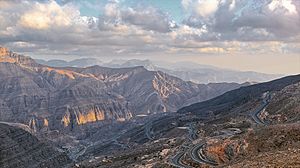
South and west of Abu Dhabi, huge sand dunes blend into the Rub' al Khali (Empty Quarter) of Saudi Arabia. The desert area of Abu Dhabi has two oases. These oases have enough underground water for people to live and grow crops. The Liwa Oasis is in the south. The Al-Buraimi oasis is about 100 km northeast of Liwa. It is on both sides of the Abu Dhabi-Oman border. Lake Zakher in Al Ain is a human-made lake. It was created from treated wastewater.
Climate
The UAE has a subtropical-arid climate. This means hot summers and warm winters. The hottest months are July and August. Temperatures can go above 45°C on the coast. In the Hajar Mountains, temperatures are cooler due to the higher elevation. In January and February, average low temperatures are between 10°C and 14°C. A humid wind called Sharqi makes the coastal region very uncomfortable in late summer.
The average yearly rainfall on the coast is less than 120 mm. But in some mountain areas, it can reach 350 mm. Rain on the coast falls in short, heavy bursts during winter. This can sometimes cause floods in dry riverbeds called wadis. Snow has been recorded in the Jebel Jais mountain cluster in Ras al-Khaimah a few times.
Cities and Landscape
The UAE has seven emirates: Dubai, Ajman, Sharjah, Abu Dhabi, Umm al-Quwain, Fujairah, and Ras Al-Khaimah. It also has over 200 islands. These islands vary in size and importance. The UAE has diverse natural landscapes. These range from steep mountains to flat coastal plains. There are high red sand dunes in Liwa. The city of Al-Ain is a natural oasis full of palm trees. Al-Ain has lower humidity and a milder climate than other cities.
Largest Cities
|
Largest cities or towns in the United Arab Emirates
2023 Calculation |
||
|---|---|---|
| Rank | Name | Pop. |
| 1 | Dubai | 3,564,931 |
| 2 | Abu Dhabi | 1,807,000 |
| 3 | Sharjah | 1,405,000 |
| 4 | Al Ain | 846,747 |
| 5 | Ajman | 490,035 |
| 6 | Ras Al Khaimah | 191,753 |
| 7 | Fujairah | 118,933 |
| 8 | Umm Al Quwain | 59,098 |
| 9 | Khor Fakkan | 53,000 |
| 10 | Kalba | 51,000 |
Tourism in the UAE
Tourism is a growing part of the UAE's economy. Dubai is the most popular tourist spot in the Middle East. It is the fifth most popular tourism destination in the world. Dubai makes up 66% of the UAE's tourism economy. Abu Dhabi accounts for 16% and Sharjah 10%. Dubai welcomed 10 million tourists in 2013.
The UAE has very modern buildings and services. Since the 1980s, the UAE has spent billions on improving its infrastructure. This is clear in Abu Dhabi and Dubai. Other emirates are also developing quickly. Tourist visas to the UAE are valid for five years since 2020. It is expected that tourism will contribute about 280.6 billion dirhams to the UAE's economy by 2028.
Transport in the UAE
Dubai International Airport became the busiest airport in the world for international passengers in 2014. It passed London Heathrow.
Abu Dhabi, Dubai, Sharjah, Ajman, Umm Al Quwain, and Ras Al Khaimah are connected by the E11 highway. This is the longest road in the UAE. In Dubai, there is the Dubai Metro, the Dubai Tram, and the Palm Jumeirah Monorail. There are also buses, taxis, and water taxis.
Salik is Dubai's electronic toll system. It started in 2007 to help manage traffic. When a car passes a Salik toll point, money is taken from a prepaid account. There are four Salik toll points in Dubai.
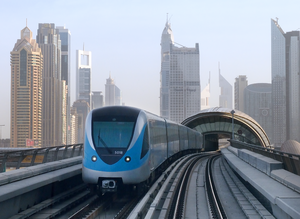
A 1200 km country-wide railway is being built. It will connect all major cities and ports. The Dubai Metro was the first urban train network in the Arabian Peninsula.
The main ports of the UAE are Khalifa Port, Zayed Port, Port Jebel Ali, Port Rashid, Port Khalid, Port Saeed, and Port Khor Fakkan. The Emirates are improving their ports to help trade between Europe, China, and Africa.
Culture
Emirati culture is based on Arabian culture. It has also been shaped by cultures from Persia, India, and East Africa. Arabian-inspired buildings show the local Emirati identity. The unique wind tower, called a barjeel, is a famous part of Emirati buildings. This design comes from Arabian influences.
The United Arab Emirates has a very diverse society. Dubai's economy relies more on international trade and tourism. It is more open to visitors. Abu Dhabi's economy focuses on oil. Its society is more traditional.
Major holidays in the UAE include Eid al Fitr, which marks the end of Ramadan. Another important day is National Day (December 2). This day celebrates the formation of the UAE. Emirati men often wear a kandura. This is a long white tunic. Emirati women wear an abaya. This is a black outer garment that covers most of the body.
Ancient Emirati poetry was influenced by the Arab scholar Al Khalil bin Ahmed. The earliest known poet from the UAE is Ibn Majid. He was born in Ras Al-Khaimah in the 1400s. Famous Emirati writers include Mubarak Al Oqaili and Salem bin Ali al Owais. The Sharjah International Book Fair is the oldest and largest book fair in the country.
The UAE has many museums. Sharjah is known for its Heritage District. It has 17 museums. In Dubai, the Al Quoz area has many art galleries and museums. Abu Dhabi is building a culture district on Saadiyat Island. This will include the Guggenheim Abu Dhabi and the Louvre Abu Dhabi.
Emirati culture is part of the culture of Eastern Arabia. Liwa is a type of music and dance. It is performed by people with African roots. The Dubai Desert Rock Festival features heavy metal and rock artists. The cinema of the United Arab Emirates is small but growing.
Cuisine
Traditional Emirati food includes rice, fish, and meat. The people of the UAE have adopted many foods from other West and South Asian countries. These include Iran, Saudi Arabia, Pakistan, and India. Seafood has been a main part of the Emirati diet for centuries. Lamb and mutton are preferred meats over goat and beef. Popular drinks are coffee and tea. They can be flavored with cardamom or saffron.
Popular Emirati dishes include threed, machboos, khubisa, khameer, and chabab bread. Lugaimat is a famous Emirati dessert.
Fast food is very popular among young people. Campaigns have been held to show the dangers of eating too much fast food. Alcohol is only allowed in hotel restaurants and bars. Pork, which is not allowed for Muslims, is sold in separate sections in major supermarkets.
Sports
Formula One racing is very popular in the UAE. A Grand Prix race is held every year at the Yas Marina Circuit in Abu Dhabi. This race starts in daylight and finishes at night. Other popular sports include camel racing, falconry, endurance riding, and tennis. Dubai also has two major golf courses.
In the past, children were used as camel jockeys. This led to much criticism. The UAE passed laws to ban child jockeys. Now, robot jockeys are used instead.
Football
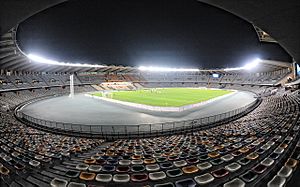
Football is a popular sport in the UAE. Teams like Al Nasr, Al Ain, and Al Wasl are very popular. The United Arab Emirates Football Association was formed in 1971. It works to promote the game and improve players and coaches. The UAE qualified for the FIFA World Cup in 1990. The UAE has won the Gulf Cup Championship twice. The country hosted the 2019 AFC Asian Cup. The UAE team reached the semi-finals.
Cricket
Cricket is one of the most popular sports in the UAE. This is largely because of people from South Asia, the UK, and Australia living there. The main office of the International Cricket Council (ICC) has been in Dubai since 2005. The UAE has many international cricket venues. These are often used for tournaments. The UAE has hosted the 2014 Under-19 Cricket World Cup and the 2021 ICC Men's T20 World Cup.
The Emirates Cricket Board (ECB) joined the ICC in 1990. The UAE national cricket team has played in the Cricket World Cup twice. The national women's team is also strong. After an attack on the Sri Lanka team in 2009, the UAE became the home ground for the Pakistan national cricket team for almost ten years. The UAE has also hosted parts of the Indian Premier League (IPL).
Education
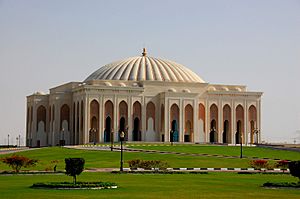
The Ministry of Education manages the school system. Public schools are free for UAE citizens. They are divided into primary, middle, and high schools. The curriculum helps the UAE's development goals. Arabic is the main language, with English as a second language. There are also many private schools.
The Ministry of Higher Education oversees universities. It also admits students to colleges. In 2015, 93.8% of adults could read and write.
The UAE is very interested in improving education and research. They have set up research centers and institutes. According to QS Rankings, top universities include the United Arab Emirates University and Khalifa University. The UAE was ranked 33rd in the Global Innovation Index in 2021.
Demographics
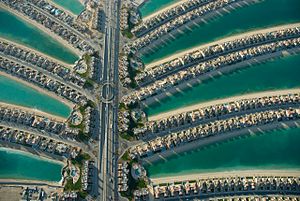
In 2020, the UAE's population was about 9.89 million. Immigrants make up 88.52% of the population. Emiratis make up the remaining 11.48%. This is because many people move to the UAE. It is very hard to become a UAE citizen unless you are born there.
The UAE has many different ethnic groups. The most common nationalities in Dubai, Sharjah, and Ajman are Indian (25%), Pakistani (12%), Emirati (9%), Bangladeshi (7%), and Filipino (5%). Over 100,000 British people live in the country. Other people come from different Arab countries.
About 88% of the UAE's population lives in cities. The average life expectancy in 2012 was 76.7 years. This is higher than any other Arab country. The UAE has more men than women. There are 2.2 males for every female in the total population.
Religion in the UAE
Islam is the largest and official state religion of the UAE. The government allows other religions to be practiced freely. It rarely interferes with non-Muslim religious activities.
Most Muslims in the UAE are Sunni. About 85% of Emiratis are Sunni Muslims. The remaining 15% are mostly Shia Muslims. They live mainly in Dubai and Sharjah. The Sheikh Zayed Mosque in Abu Dhabi is the largest mosque in the country. It is a major tourist attraction.
Christians make up about 9% of the population. Many Christians in the UAE are from Asia, Africa, Europe, and other Middle Eastern countries. The country has over 52 churches.
There is a small Jewish community in the UAE. Before 2023, there was one synagogue in Dubai. Another synagogue, Moses Ben Maimon Synagogue, opened in 2023 in Abu Dhabi. It is part of the Abrahamic Family House complex. It is estimated that up to 3,000 Jews live and worship freely in the UAE.
| Religions in UAE in 2010 (Pew Research) | ||||
|---|---|---|---|---|
| Religion | Per cent | |||
| Islam | 76% | |||
| Christianity | 13% | |||
| Hinduism | 7% | |||
| Buddhism | 2% | |||
| Other | 1% | |||
| None | 1% | |||
South Asians are the largest ethnic group in the UAE. Over 2 million Indian migrants live there. There are three Hindu temples in the country. Other religions like Jainism, Sikhism, Buddhism, and Baháʼís also exist.
In 2019, the UAE announced plans for the Abrahamic Family House. This complex will have a synagogue, a mosque, and a church. It will be on Saadiyat Island in Abu Dhabi.
Languages
Arabic is the national language of the United Arab Emirates. The Gulf dialect of Arabic is spoken by Emirati people.
Images for kids
-
2nd century BCE era jar found in Mleiha Archaeological site in Sharjah.
-
A painting of the Portuguese Empire Doba Fortress in Dibba Al-Hisn in 1620.
-
Purple – Portuguese in the Persian Gulf in the 16th and 17th century. Main cities, ports and routes.
-
Dhayah Fort at the hill top. In 1819 it was the last Al-Qasimi stronghold to fall in the Persian Gulf campaign of 1819. The fall of Dhayah was to pave the way for the signing of the General Maritime Treaty of 1820.
-
View of Dubai
-
Roads leading to Jebel Jais, the highest mountain in the UAE (1,892 m), in Ras Al Khaimah.
-
Minister of Foreign Affairs Abdullah bin Zayed Al Nahyan with U.S. Secretary of State Mike Pompeo, 2018.
-
Sheikh Mohammed bin Zayed Al Nahyan and U.S. President Donald Trump in Washington DC, May 2017.
-
Russian president Vladimir Putin meeting with Sheikh Mohammed bin Zayed in Abu Dhabi in October 2019.
-
United Arab Emirates Air Force F-16 Block 60 "Desert Falcon", taking off from the Lockheed Martin plant in Fort Worth, Texas.
-
Two south Asian blue-collar workers posing for a picture with Burj Khalifa on the background.
-
A traditional souk in Deira, Dubai
See also
 In Spanish: Emiratos Árabes Unidos para niños
In Spanish: Emiratos Árabes Unidos para niños




